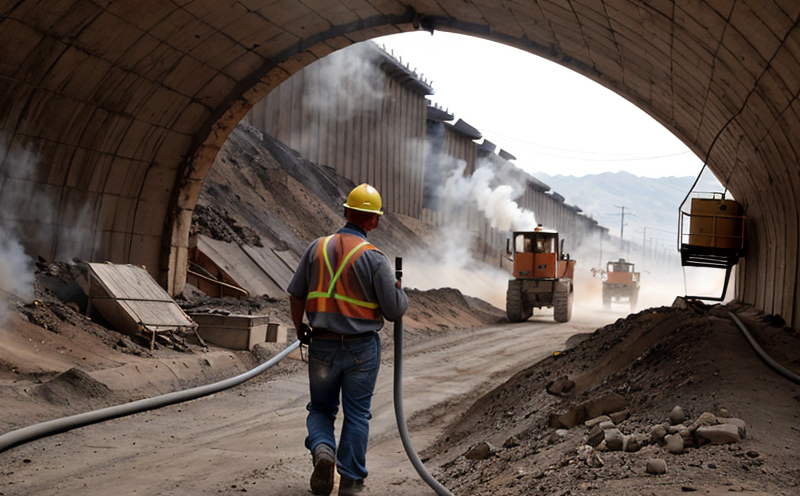Quartz Content in Respirable Mine Dust by XRD Testing
The quartz content in respirable mine dust is a critical parameter in mining operations. Quartz is a common crystalline form of silica and can cause significant respiratory health issues when present in respirable dust at high concentrations. The inhalation of fine quartz particles, known as cristobalite or tridymite, can lead to silicosis—a potentially fatal lung disease characterized by progressive fibrosis of the lungs.
Understanding the quartz content is essential for mine operators and health and safety professionals to ensure compliance with occupational exposure limits set forth by regulatory bodies. These regulations are designed to protect workers from adverse health effects associated with respirable dust containing crystalline silica. The European Agency for Safety and Health at Work (EU-OSHA) and OSHA in the United States provide guidelines that specify permissible levels of quartz content in mine environments.
The X-ray Diffraction (XRD) technique is widely used to analyze the crystalline components of dust samples, including quartz. This method involves directing X-rays onto a sample, which then diffract based on the crystal structure of the material present. The resulting diffraction pattern is analyzed using specific software algorithms that identify and quantify each component within the sample.
At Eurolab, we employ state-of-the-art XRD instruments to perform this analysis with high precision and accuracy. Our dedicated team of experts ensures that samples are prepared according to strict protocols to ensure reliable results. This includes thorough cleaning of the sample to remove any non-crystalline silica or other contaminants that might interfere with the analysis.
The process begins by collecting dust samples from various areas within the mine, including potential hotspots where quartz levels may be higher. These samples are then carefully prepared using techniques such as sieving and wet digestion to ensure they are representative of respirable dust. The sample is then loaded into the XRD instrument for analysis.
The results obtained from our testing provide valuable insights into the presence and concentration of quartz in the mine environment. This information can be used by mining companies to implement control measures aimed at reducing exposure levels, thereby enhancing worker safety and compliance with regulatory standards. The data generated from these tests is also crucial for conducting risk assessments and informing decisions on ventilation systems and dust management practices.
Our XRD testing service not only helps in meeting legal requirements but also supports continuous improvement initiatives within the mining sector. By providing accurate and timely information about quartz content, we enable mines to make informed decisions that contribute to a safer working environment for all personnel involved.
Applied Standards
| Standard | Description |
|---|---|
| ISO 14683:2017 | Method for the determination of crystalline silica in air using X-ray diffraction (XRD). |
| ASTM D5289-16 | Standard test method for quantitative determination of quartz by X-ray diffraction analysis. |
| EN 3041:2017 | Method for the determination of crystalline silica in respirable dust using XRD. |
Benefits
The benefits of quartz content analysis by XRD testing are numerous and far-reaching. Firstly, it provides mining companies with a clear understanding of the level of exposure to respirable dust containing crystalline silica in their operations. This knowledge is crucial for identifying areas where improvements can be made to reduce risks associated with silicosis.
Secondly, compliance with regulatory standards is significantly enhanced through accurate and reliable testing results. Regulatory bodies rely on such data to ensure that mining environments meet occupational exposure limits set forth by international guidelines like those provided by EU-OSHA and OSHA.
In addition to regulatory compliance, this service also supports the broader goal of promoting worker safety within mines. By monitoring quartz content levels regularly, employers can implement targeted control measures such as improved ventilation systems or personal protective equipment (PPE) where necessary. This proactive approach helps create a safer work environment and fosters a culture of occupational health and safety.
The insights gained from XRD testing also play an important role in environmental management strategies. Monitoring quartz content can help identify sources of dust pollution both within the mine itself and possibly beyond its boundaries, allowing for better planning to mitigate adverse impacts on surrounding communities.
For research and development (R&D) teams, this service offers valuable data that supports ongoing efforts to develop new technologies or processes aimed at reducing exposure risks. It provides a benchmark against which improvements can be measured over time, helping drive innovation within the industry.
Eurolab Advantages
At Eurolab, we pride ourselves on offering comprehensive and reliable testing services tailored specifically to meet the needs of the mining sector. Our expertise lies not only in executing precise XRD analyses but also in providing actionable insights based on those results.
We have a team of highly skilled professionals who are well-versed in all aspects of quartz content analysis, ensuring that every test conducted meets the highest standards of accuracy and repeatability. Our commitment to quality is reflected in our use of cutting-edge instrumentation provided by leading manufacturers, which guarantees consistent and reproducible results.
Moreover, we understand that successful testing requires more than just technical proficiency; it demands a deep understanding of the mining industry itself. That’s why our team works closely with clients throughout the entire process—from sample collection to final report delivery—to ensure every step is executed correctly and effectively. This collaboration ensures that the information provided is not only accurate but also relevant to real-world conditions.
Finally, we offer fast turnaround times, allowing you to receive your reports promptly so that you can act quickly on any findings or recommendations. Whether you need periodic monitoring or one-off evaluations, Eurolab is here to support you every step of the way.





